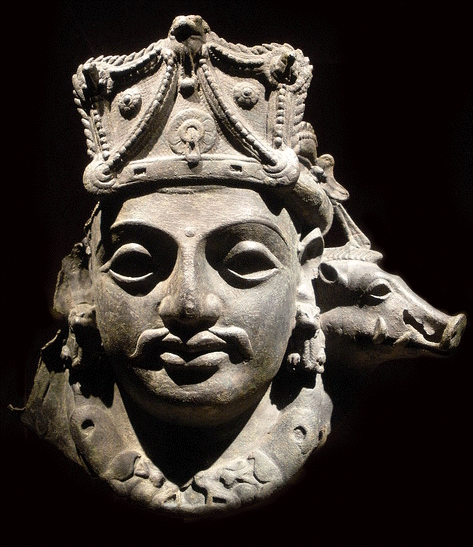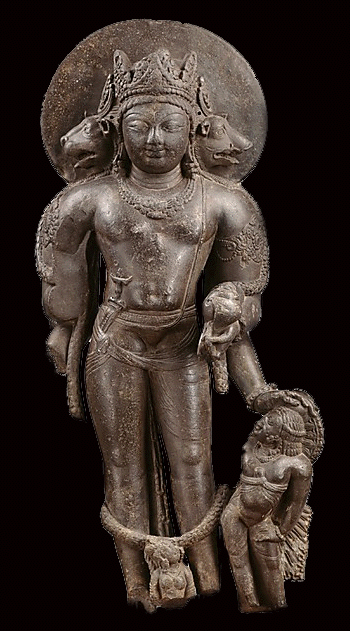
|
|
|
|
BY: SUN STAFF

Lord Vishnu as Para-Vasudeva Feb 12, 2012 — CANADA (SUN) — A serial presentation of the Pancaratra and the Ahirbudhnya Samhita. Under the broad category of the Pancaratra Agamas there are three main bodies of Agamic texts: the Saiva, Sakta and Vaisnava. Each of these agamic schools has its own Pancaratras. The Agamas are generally comprised of four subject matters: jnana (knowledge); kriya (construction of temples, installation of deities, etc.); carya (religious conduct and activities); and yoga (devotion or attention). All of the Agamas accept the existence of a supreme being with a predominant male or female aspect, the existence of undivided souls, the reality of the objective universe, and devotion as the only means of liberation. Pancaratra is said to be especially applicable in the Kali-yuga, being as good as the Veda, because it was spoken by the Lord Himself to Brahma, when Brahma inquired as to how the Lord should be worshiped. There are various explanations for the term 'Pancaratra'. It is said that Lord Visnu spoke these instructions over the course of five nights (panca ratri) of Brahma. The Pancaratra is often used to refer to five processes, such as karma, jnana, astanga-yoga, sankhya, and so on. The samhita we will focus on in this series, Ahirbudhnya-samhita, says that Pancaratra has it name because it deals with the five-fold manifestation of Lord Vasudeva: Para, Vyuha, Vibhava, Arca and Antaryami. In his Navadvipa Mahatmya, Srila Bhaktivinoda Thakur writes: "The five rsis (Sandilya, Upagayana, Maunjayana, Kausika, and Bharadvaja) were previously each instructed for one day and night (panca-ratra, "five nights") by Lord Narayana. Headed by Narada Muni they wrote the Pancaratra here (in Vidyanagara) to teach the people about practical devotional service." (Chapter 13) There are 59 types of Pancaratras, one of which is this Ahirbudhnya. There are said to be 108 Pancaratragamas, but most of them are lost. Gaudiya Vaisnavas follow the Pancaratra which belongs to daksina-marga, addressing arcana, murti worship. Gaudiyas don't practice vama-marga, an adulteration of which is known in the West as 'sexual tantra'.

Lord Vishnu as Para-Vasudeva, or According to the Vedic Encyclopedia, "Gaudiya Vaisnavism teaches both Bhagavata marga and tantra (Pancaratra) marga. In the Bhagavata Purana, tantra is mentioned several times. In 1.3.8, Narada is credited with founding the satvata-tantra, which is identified by the commentators as Pancaratragama. This is pretty much the consistent interpretation given throughout, in the few places that the word comes up. In 11.3 there's a discussion of both Bhagavata-dharma and Karma, which is divided into Vaidika and Tantrika portions. This duality (veda-tantra) comes up more than once in the Bhagavata (e.g. 8.6.9, 11.5.28, 11.11.37, 11.27.7, 11.27.26, 11.27.49, 12.11.4), reflecting concerns in South India about these two paths as being in need of synthesis. Yamunacarya's Agama-pramanyam is the principal reflection of this conflict. In 11.5.31-32, where the Kali yuga avatar is introduced, it says "nana-tantra-vidhanena", which Sridhar Swami glosses "kalau tantra-margasya pradhanyam darzayati," meaning that this text is meant to show that the Tantric path is predominant in the age of Kali. On the whole a marked distinction is being made between the Agama-marga as a "karma" leading to purification and the Bhagavata dharma leading to ecstasies in sravana-kirtan, etc. Both Pancaratrik and Bhagavata sampradayas accept aspects of the other. Pancaratra is more concerned with ritual, Bhagavata with bhava. Both acknowledge that the other path complements their own (as Rupa Gosvami does in Bhakti-rasamrtasindhu 1.1.11), but they nevertheless give prominence to one or the other. This Visvanatha Cakravarti clearly points out in 11.3.33. Bhaktisiddhanta Sarasvati identified Bhagavata marga with raganuga bhakti and Pancaratra with vidhi. The function of vidhi is mentioned in Padma Purana quoted in Bhakti-rasamrtasindhu 2.8: smartavyah satatam visnur vismartavyo na jatucit sarve vidhi nisedhah syur etayor eva kigkarah All vidhis should be understood as servants of two principles: constant remembrance of Visnu without ever forgetting Him. tatha cha visnu-yamale— krite sruty-ukta-margah syat tretayam smriti-bhavitah dvapare tu puranoktah kalav agama-sambhavah (5.4) And also in Visnu Yamala— In Satya Yuga the path was to follow the Srutis, in Treta the Smrtis, in Dvapara the Puranas and in Kali the Agamas. (quoted in Hari-bhaktivilasa 5.4)" In our next segment, we will begin a presentation of select passages from Introduction to the Pancaratra and the Ahirbudhnya Samhita by F. Otto Schrader (Madras, 1916). Schrader made his English translation of this Sanskrit text while being held captive as a prisoner of war in Ahmednagar. The Ahirbudhnya Samhita provides a fascinating array of detailed information on the Supreme Personality of Godhead's various incarnations, expansions and plenary portions; the hierarchical elements of creation; the nature of the soul, and many other aspects of spiritual knowledge. REFERENCES:
| |